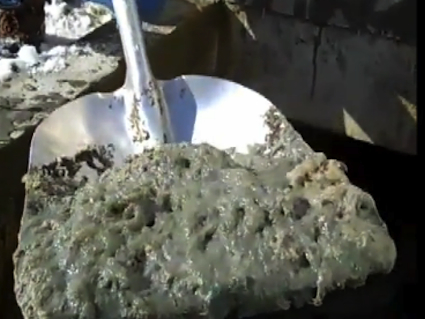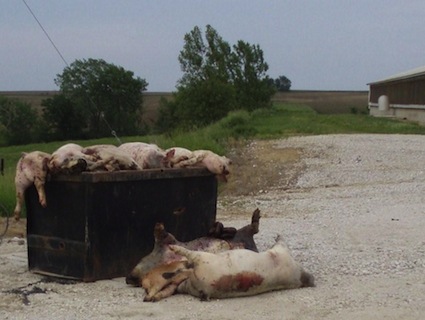
<a href="http://www.flickr.com/photos/timypenburg/5378570040/sizes/z/in/photostream/">Tim Geers</a>/Flickr
This story was originally published by OnEarth.
Before I even stepped from my truck onto the gravel outside the New Fashion Pork hog confinement facility, Emily Erickson, the company’s animal well-being and quality assurance manager, handed me a pair of stretchy white plastic footies to put over my shoes. It was a blustery day in September, the sky threatening snow—the first hint of winter, when cold, dry air stabilizes viruses and biosecurity becomes a topmost concern.
All of the hogs inside the confinement near Jackson, Minnesota, just north of the Iowa state line and on the headwaters of the Des Moines River, would be sold to Hormel Foods. Hormel would soon post record profits on the strength of sales of Spam to Asian markets and the expansion of the company’s China operations. But Jim Snee, head of Hormel Foods International, announced that the company was making an even bigger push, to firmly establish Spam in Chinese grocery stores before products from its competitor Smithfield Foods, purchased by Shuanghui International in May, could elbow them out. As a major supplier to Hormel’s Spam plants in Minnesota and Nebraska, New Fashion Pork was racing to keep pace with demand. The last thing the company could afford was an outbreak of disease.
To an outsider, the hog industry’s vigilance against external pathogens—symbolized by those hygienic footies—can seem strangely at odds with its dismissal of concerns about the effects of its facilities on human health. Large producers like New Fashion insist that the enormous, concrete-reinforced waste pits under each confinement—many with a capacity of 300,000 gallons—effectively prevent contaminants from leaching into the soil, and that manure is carefully managed by the Iowa Department of Natural Resources under laws aimed at accounting for all manure at all times. But mounting evidence suggests that an unprecedented boom in Iowa’s hog industry has created a glut of manure, which is applied as fertilizer to millions of acres of cropland and runs off into rivers and streams, creating a growing public health threat. Meanwhile, the number of DNR staff conducting inspections has been cut by 60 percent since 2007.
Between May and July 2013, as downpours sheeted off drought-hardened fields, scientists at the Des Moines Water Works watched manure contamination spike to staggering levels at intake sites on the Raccoon and Des Moines rivers. These two major tributaries of the Mississippi are also the usual sources of drinking water for roughly one out of every six Iowans. But at one point last summer, nitrate in the Raccoon reached 240 percent of the level allowed under the Clean Water Act, and the DMWW warned parents not to let children drink from the tap, reminding them of the risk of blue baby syndrome. (Nitrate impairs the oxygen capacity of the bloodstream; in babies and toddlers the syndrome can effectively cut off their air supply, rendering them a deathly blue.)
Mounting concern about the safety of concentrated animal feeding operations (CAFOs) has stoked a public outcry. So, to be honest, I was shocked when Brad Freking, the CEO of New Fashion Pork, agreed to allow me to tour one of its facilities. In the changing room, I zipped into some navy coveralls and slid a pair of clear plastic boots over a second set of footies. Emily Erickson turned the handle to the barn entrance, opening the heavy steel door a crack. The sound of squealing hogs spilled into the room. “If you’ve never been inside,” she warned, “it’s a lot of pig, it’s a lot of metal, it’s a lot of noise.” I assured her I was ready, and we headed inside.
Erickson was right: it is a lot of pig. Under the yellow light of a series of bulbs, 1,000 hogs, divided according to size and approximate age, jostled and jockeyed in large holding pens. They pressed their wet snouts through the metal gates, snuffling and grunting curiously, but scrambled away as Erickson led me down the side aisle. Some, in fits of momentary panic, let out high shrieks, which echoed off the steel roof, setting off cascades of squeals.
By this time, these hogs had been through almost the entire process: conceived via artificial insemination in sows held in gestation crates; transferred briefly to farrowing crates for milk-feeding; then, at three weeks old, trucked to this wean-to-finish operation and raised on corn and soybeans delivered by automatic feeders. Within two or three months, when they hit target weight, they would be loaded into trucks and brought to slaughter at the Hormel plant in Austin, Minnesota.
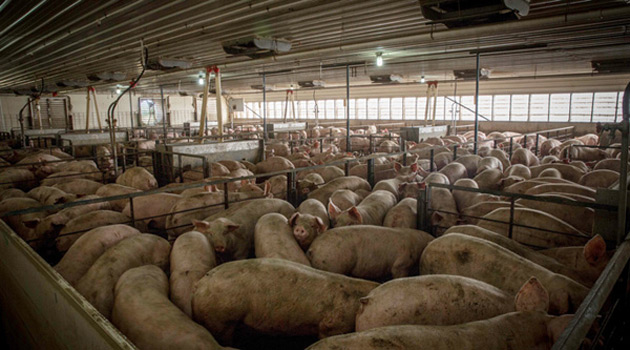
Massive amounts of antibiotics are used in the meat industry to promote growth and speed this process. Public health advocates including NRDC have warned that the bacteria in CAFO waste pits like the one under our feet can build antibiotic resistance before being spread across surrounding fields and running off into the water. Freking told me, however, that New Fashion Pork does not use hormones or antibiotics to promote growth. But the company does finish its female hogs with a month-long course of ractopamine, a steroid-like feed additive that increases leanness. (China has banned its use, a factor in the purchase of Smithfield, which used the additive in only 40 percent of its meat and since the sale has gone ractopamine-free.)
But more than sight or sound or even worries about superbugs, what hits you in a pig barn is the smell. The hogs scattered and reconvened as we walked, their hooves clicking anxiously on the slotted wooden floors; their waste, some still fresh and moist, was spread on the floor and smeared over their haunches and feet, slowly working its way down through the slats into an enormous underground pit. Still more waste had dried and turned powdery, creating a choking haze that swirled in the dim light. It carried with it a hot, fleshy stink—not just a smell but an astringent, chemical burn that sears your nostrils.
On the back wall, giant fans vented ammonia, hydrogen sulfide, methane, and other dangerous gases that rise from decomposing manure. A report published jointly by the University of Iowa and Iowa State University in 2002 concluded that air pollution from large-scale confinements “may constitute a public health hazard,” explaining that the problem did not arise primarily from the containment of manure in waste pits but from its application aboveground as fertilizer. (The report attributed fully 80 percent of hazardous gas release to the first six hours after this was done.) In response, the DNR announced new air-quality regulations. But Iowa lawmakers, most of whom count agribusiness among their biggest donors, overruled those standards within days. Instead, new guidelines were established requiring liquid manure to be immediately plowed under or injected directly into the subsoil, preventing harmful gases from escaping into the air.
But then came a revolution in the corn industry. In 2005 Congress approved the first Renewable Fuel Standard, requiring the production of at least 7.5 billion gallons of renewable transportation fuels by 2012, creating an overnight demand for ethanol—and therefore for corn. The market price quadrupled, encouraging farmers to plant more and more rows into already overplanted fields. The steep jump in feed prices tipped many struggling hog operations toward bankruptcy.
To stabilize the market, several meatpackers were granted exemptions to state laws prohibiting them from owning livestock or feed crops—which brought in out-of-state dollars but also touched off a boom in CAFO-building financed by some of the nation’s largest hog producers. In 2000, 38 permits had been issued statewide to construct or expand animal confinements large enough to require permitting by the DNR; by 2006, the number had vaulted to 318. Iowa now has more than 8,500 factory farms, and is by far the country’s biggest hog producer. More than 18 million of its 20 million hogs are raised in CAFOs—most owned by or under exclusive contract to industry giants such as Smithfield, Cargill, Tyson, or Hormel.
To support this boom, however, the industry needed buyers. The fiercest competition has been for expanding Asian markets, which is why Iowa’s Republican governor, Terry Branstad, and other Midwest governors have made repeated overtures to Japan, China, and South Korea—which collectively import more than $3 billion worth of American pork each year. In April 2013, Branstad met with Chinese president Xi Jinping in Beijing; two months later, representatives from Hebei Province attended the World Pork Expo in Des Moines and struck a deal not only to buy more Iowa hogs but also to learn breeding and herd management techniques.
Industry leaders and politicians alike have trumpeted the jobs created by these growing partnerships with China, but the rapid expansion of the hog industry to meet export demand has had a devastating effect on Iowa’s waterways. With farmers now plowing under vegetation and planting every available acre to corn, soil is eroding at an accelerating rate. And when precious topsoil is lost during spring melt and heavy rains, farmers apply more fertilizer to jump-start the crop.
According to David Goodner, a spokesman for the watchdog group Iowa Citizens for Community Improvement, Iowa’s factory farms now produce well over five billion gallons of liquid manure a year. The laws governing application of manure may mask the problem by reducing the level of harmful gases in the air, he said, but vast quantities of waste are being injected directly into the drought-stricken and highly erodible soil. The ground simply can’t hold all the nitrates and bacteria being produced by so many hogs.
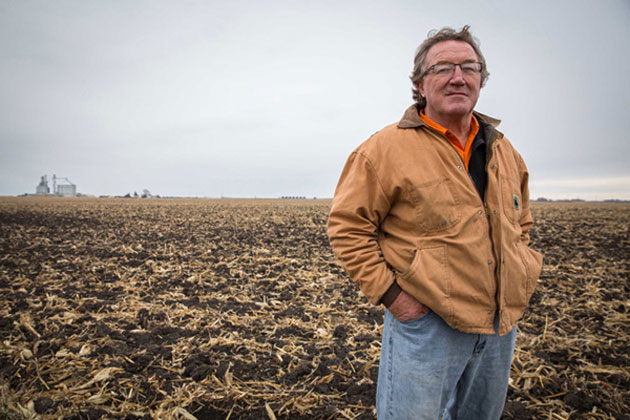
Jay Lausen is soft-spoken, with wispy blond hair and a shy smile. He doesn’t seem like the kind of guy who goes looking for trouble, but when New Fashion Pork applied to build a hog confinement less than a mile from his home in 2011, he decided to put up a fight. Lausen’s roots run deep around Estherville, Iowa, a small farming community a few miles from the Minnesota border. His family’s century farm is just six miles from where he and his wife are home-schooling their four children, in the same house where Lausen grew up with his four older siblings.
Before New Fashion purchased the 160 acres where it intended to build, Lausen had farmed the land himself, renting it from a neighbor. He knew the spine-like ridge dividing the acreage was critical to the watershed. While he had farmed the east side, he had enrolled the west side, some 50 acres, in the Conservation Reserve Program, an initiative of the US Department of Agriculture (USDA) to take environmentally sensitive land out of crop production by paying farmers to instead plant native grasses, windbreaks along property lines, and evergreens to hold soil along waterways. Even with the improved ground cover, a serpentine gully cut across the acreage toward the southwest fence corner, where runoff pooled and swelled into a culvert that drained into the West Fork of the Des Moines River, about half a mile away.
Large sections of the river in Emmet County had been on the DNR’s list of impaired waterways for years, so when the landlord said she intended to put the property up for auction in November 2011, Lausen hoped the department would snap it up. After all, it had bought adjacent land on two sides and even paid to undercut the dirt road to reestablish natural drainage as part of a wetland restoration program. But when the auction came around after Thanksgiving of that year, the DNR was nowhere to be found. The high bid came from New Fashion Pork.
When Lausen called the department to discuss the building plans, he found that the company intended to erect a 2,400-head wean-to-finish operation. However, the state doesn’t count livestock by heads but by “animal units”—one such unit being the standard weight of a cow ready for slaughter. A hog is considered 0.4 animal unit; thus, the operation was proposed to hold 960 units, just below the 1,000-unit size that requires a construction permit under DNR rules. And, just as Lausen suspected, the required manure management plan called for injecting the contents of the facility’s waste pit into the surrounding fields—including the 50 acres that drain directly into the Des Moines River. So he started digging through USDA data, DNR reports, state department of health records, researching all of the regulations governing the permitting of CAFOs. What he found about DNR enforcement of those regulations was even more troubling.
After more than a decade out of office, Terry Branstad was again elected governor in 2010. In the next few months, he eliminated 100 positions at the DNR, including 14 vacant jobs in CAFO inspection and enforcement. Wayne Gieselman, the agency’s head of environmental compliance, told the Associated Press that these cuts would hurt enforcement: “If we could be on site on a more regular basis, producers would know we’re watching.” Branstad told Roger Lande, the attorney for the powerful Iowa Farm Bureau whom he had just appointed as director of the DNR, that he wanted Gieselman gone. And he was, within a week. The governor certainly “wanted his own people in there,” Gieselman told me when I reached him by phone in Kansas, where he now works for Region 7 of the EPA.
Branstad also announced four appointments to the nine-member Iowa Environmental Protection Commission: a past president of the Iowa Pork Producers Association, the CEO of a hog-confinement construction company, the CEO of an agricultural lobbying firm, and a former Iowa House member known for her efforts to loosen laws governing the application of manure from confinements.
In August 2011, just before the sale of the land near Estherville, the Washington, D.C.–based Environmental Integrity Project, joined by the Iowa chapter of the Sierra Club and Iowa Citizens for Community Improvement, filed notice of intent to sue the EPA for failing to answer an earlier petition to take over enforcement of the Clean Water Act from the state of Iowa. The DNR responded by issuing plans to improve water quality but cautioned that the downsized department was overmatched by the problem.
Last fall the department allowed me to accompany environmental specialist Don Cunningham on an inspection of another New Fashion Pork facility, near Estherville. He told me that inspectors circle a facility—checking for cracks in the foundation that could leak manure or problems with venting fans—but do not enter the confinement as part of normal procedure. At the end of the walk-around, Cunningham told Jay Moore, New Fashion Pork’s environmental construction manager, that the company was past deadline for new soil samples and that a well on the property seemed to be closer to the confinement than claimed on the permit. (Moore later conceded this.) Cunningham informed Moore that there would be a formal notice of violation—the site’s second in 18 months. New paperwork would need to be submitted. After that, everything would proceed as before. Within days, the confinement’s pit was pumped as low as possible and the fields were injected with hundreds of thousands of gallons of manure.
I asked Cunningham how such perfunctory inspection squared with the DNR’s own estimate that the Raccoon River watershed, which feeds directly into the Des Moines River, needed a 50 percent reduction in nitrate levels and a staggering 99 percent reduction in E. coli just to come into compliance with federal standards. He responded cautiously: he sticks to his job description, inspecting manure management plans, ensuring compliance with existing regulations, and reporting problems when he observes them. Cunningham doesn’t make the laws; he just enforces the laws the politicians give him.
Jay Lausen realized that the DNR, under the thumb of an ag-friendly governor, would never intercede against New Fashion Pork—or any other hog producer. The only hope was to block construction at the local level. In advance of the April 2012 meeting of the Emmet County supervisors, at which New Fashion’s proposal would come to a vote, Lausen asked to address the board. He distributed copies of his research along with USDA data, showing that 60 percent of the property lay on the Des Moines River watershed, classified by the DNR as endangered. But Jay Moore came armed with statistics of his own, showing that the company supported 17 full-time employees in the county and tallying the tax dollars and other economic benefits to the local economy. Moore assured the board that his company understood small agricultural communities. “It’s still run as a family operation,” he said.
“How many family-run operations have 320 employees?” Lausen retorted. “This is corporate farming.”
Nothing gets under Brad Freking’s skin quite so much as when people in northern Iowa call him a corporate farmer. “Like we’re these big guys from out of state,” he said to me ruefully. New Fashion’s headquarters are barely 20 miles from Estherville. In the conference room where we sat, Hormel Spirit of Excellence plaques stood lined up on the mantel above a wide fireplace, and Freking sipped from a Hormel mug. He is a wiry man in his forties, soft-spoken and careful in choosing his words. He freely admitted that he had been advised against our meeting, but he said there was nothing to hide so he wasn’t going to duck my questions. “Call us a little bit unique in that,” he said.
Freking grew up on a 200-head hog farm in Jackson County, Minnesota, graduating from the local high school in 1986 at the very height of the worst agricultural downturn since the Great Depression. With no prospects for farming at the time, he went first to South Dakota State University, where he got a degree in animal science, then continued on to veterinary school at the University of Minnesota. In 1994, he came home with his wife to found New Fashion. “It started extremely small,” he told me, “producing about 16,000 pigs a year.” But Freking’s company grew more slowly and more strategically than his competitors, so the downturn in the hog industry in 1998 presented an unusual opportunity. “We were, financially, in a very good position at that time,” he said. “So we started acquiring distressed sow farms.” That’s why New Fashion’s operation is so geographically diverse. Freking bought failing breeding barns from the Rockies to the Great Lakes, building what he calls a “sow base.”
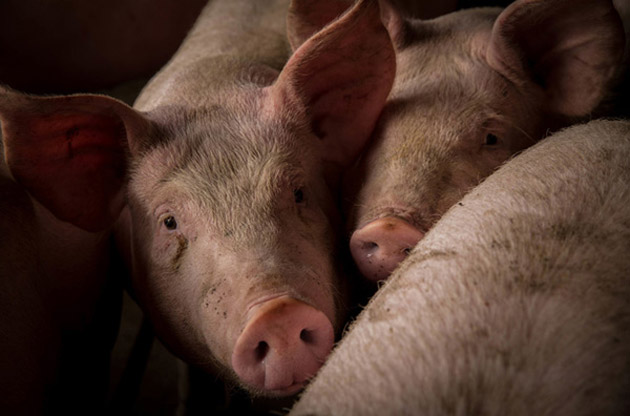
In 2004, just as this period of acquisition was ending, Iowa began exempting big packers from its vertical integration laws. New Fashion Pork, with its sow base expanded from fewer than 1,000 to more than 50,000, joined in the boom, building as fast as it could and aggressively investing in every link of the supply chain. Today, New Fashion Pork not only raises 1.2 million hogs per year—about half of those in some 50 wean-to-finish facilities across northern Iowa—but also owns hundreds of thousands of acres of farmland and dozens of feed mills. It produces so much manure that it now markets its own line of fertilizer injectors. The company has been recognized by Hormel Foods as one of its top suppliers of gilt hogs (young females), and New Fashion processes its barrows (males) at its own packing plant in St. Joseph, Missouri, for export to Asia in partnership with four other producers, most notably Christensen Farms, under the name Triumph Foods. That plant processes 24,000 hogs per day, making it the second-largest hog kill in the United States. The result of all this integration, Freking told me, is that “we’re not only producing pigs. Now we’re producing pork.”
The whole process is made possible by injecting cheap manure into cornfields. “It is a great model, if you think about it,” Freking said. “Here’s my farm, and I put my pig barn on my farm and then I take the organic nutrients out of that pig and put it on the farm to grow the corn to feed the pig. It’s very sustainable.” Freking allowed that not every company lives up to the standard he expects from his facilities, especially in cash-strapped times. “When I think about the acquisitions I did of failing farms,” he said, “most of them had environmental issues. That’s true from Wyoming to Indiana.” Still, given the construction standards imposed on waste pits and the piles of paperwork that must be completed to stay in compliance with the DNR, Freking and Moore both told me they saw no reason to believe that hog confinements contribute more to water contamination than small town water-treatment plants that flush their systems during flooding.
Later, when I visited the laboratories at the Des Moines Water Works, I asked Dennis Hill, the DMWW’s microbiologist, about this argument. “Those little towns might as well straight-pipe their sewage to the river,” he scoffed. “Compared to what comes in from agriculture, it wouldn’t make any difference.”
With its soaring, vaulted ceiling and churchlike quiet, the filter building at the Des Moines Water Works can feel like a cathedral. Tucked into niches on either side of the tiled gallery, the filters themselves look like soaking pools at some long-forgotten Turkish bath. But their green-hued waters are pumped in from the Raccoon and Des Moines rivers, then slow-filtered, up to 50,000 gallons at a time, through 100 tons of gravel and 130 tons of sand. Linda Kinman, the policy analyst and watershed advocate at DMWW, told me that this building has been in use since the 1940s. But the process it employs is ancient in its simplicity and has worked with time-tested efficiency—until recently.
Scientists at the water works have been tracking steady increases in levels of nitrates and E. coli in the contributing watersheds since the 1970s, when industrial agriculture first hit its stride. But in the past decade those levels have started to pose greater and greater threats to public health, and last year the situation reached a crisis. The DMWW turned off its intakes from the two rivers and began drawing from alternative sources—lakes under its control, an aquifer storage system, the utility’s underground filtration and storage hold, and neighboring waterworks. By late July, the water flowing through the pipes was registering 9.65 milligrams per liter of nitrates, just under the 10 mg/L allowed by the EPA. Kinman was granted a face-to-face meeting with the federal agency and the Iowa DNR to discuss ways of reducing nitrate loads—but came away with no assurances.
“The political scene in Iowa right now is almost over?the?top supportive of agriculture,” Kinman told me.
After the Iowa environmental groups filed notice of intent to sue in 2011, the EPA was finally forced to act. In July 2012 it issued a scathing critique of the DNR’s handling of the state’s factory farms, finding that it had failed to properly issue required permits for operating such facilities, to administer inspections, to respond to manure spills and other environmental violations, and to assess adequate fines and penalties when violations did occur. But nearly a year later, the state had still failed to take any action. Given the dangerous levels of nitrates at that time—and the overall trend line of water contamination—Kinman told me, “At some point, we will violate.”
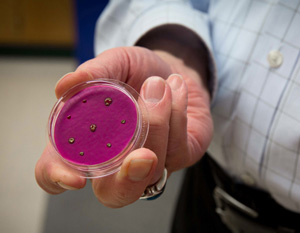
Apparently fearing that the crisis would give the EPA leverage to intercede, Governor Branstad took preemptive action. On May 20, 2013, he sent a letter to acting EPA Administrator Bob Perciasepe and Assistant Administrator Gina McCarthy, whom President Obama had nominated to helm the agency. Branstad denounced CAFO compliance inspections as “the ‘gotcha’ approach.” He insisted that “the majority of discharges into Iowa’s waters are accidental spills” and claimed that runoff was unavoidable because it was “caused by Mother Nature.” He invited McCarthy to come to Iowa and meet with livestock industry leaders.
Last August, McCarthy—who had just been confirmed by the Senate—met with Farm Bureau members under the picnic shelter at the Iowa State Fairgrounds and pledged to establish a “more trusting relationship between EPA and the agriculture community.” Jay Moore of New Fashion Pork told me, “It was just refreshing to hear her talk.” Within weeks, the EPA and Iowa had struck a deal: the state would reopen hiring for 7 of the 14 positions eliminated by the governor since 2011 and would allocate roughly $30 million to water quality initiatives.
Scientists at DMWW point out that the Raccoon and Des Moines rivers have the highest and second-highest nitrate concentrations of the 42 major tributaries to the Mississippi. The $30 million allocation, they say, is just too little to address such an enormous problem. “I have four little grandkids,” Kinman said. She tells her daughter, who lives in a rural community, not to give her children tap water. “There are companies that make special bottled water for infants. I said, ‘You buy that in the spring and the fall.'”
After Jay Lausen’s impassioned appeal to the county supervisors, a group of concerned citizens called a public meeting to consider legal options for opposing the proposed New Fashion Pork facility outside Estherville. More than 100 people gathered in the gymnasium of the local Regional Wellness Center. Brad Freking went, too, and fielded more than an hour’s worth of questions. “We are pretty comfortable with the site,” he told the crowd, but by the end of the evening he promised, “We’re going to pursue an alternative location if possible.” And that’s exactly what they did.
Freking told me he had gained “tremendous respect” for the Iowa Great Lakes Watershed and the rivers it feeds and had learned to consider community concerns before purchasing property or applying for a permit to build. “You understand the watersheds, and you just stay out of them,” he said. “That’s our approach.”
Later, I recounted that conversation to Lausen. I asked him if this might represent a ray of hope—and a way forward. Sure, the EPA appeared cowed by political pressure and, yes, the Iowa Department of Natural Resources, hamstrung by the governor and the legislature, seemed unlikely to carry out more than minimal enforcement of the Clean Water Act. But maybe direct public pressure was enough to appeal to the conscience of these businesses.
Lausen broke out in a broad smile. “You haven’t seen where they built instead, have you?” he asked.
By the time I arrived at the new site, the sun had burned through the morning rains. The cold of weeks before had turned into a brief, unseasonable warm-up. The sun was so bright, in fact, that we could see light glinting on the water running off the newly fertilized fields toward Brown Creek, right where it passes under a bridge and bends into a stand of trees on its way to the Des Moines River. The fields surrounding the New Fashion Pork facility, new and bright-white on the hill, drained directly into a DNR-maintained wildlife management area.
The new site might seem absurd, but it deftly swings to the east, avoiding Estherville and local opposition. But what about the people downstream in Emmetsburg or Fort Dodge or the half-million people who depend on the river in Des Moines? For that matter, what about St. Louis and Memphis, Baton Rouge, and New Orleans? What about everyone from here to the Gulf Coast who goes to the tap expecting to find clean, safe water? As long as the hog industry runs wild in Iowa, that question will be harder and harder to answer.


